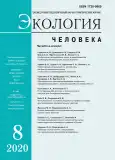PERIPHERAL BLOOD LYMPHOCYTES ADENOSINE TRIPHOSPHATE AVAILABILITY AMONG THE RESIDENTS OF THE NORTHERN EUROPEAN RUSSIA
- 作者: Zubatkina O.V.1, Dobrodeeva L.K.1, Popov A.A.2, Samodova A.V.1, Kruglov S.D.1
-
隶属关系:
- Institute of Environmental Physiology of N. Laverov Federal Center for Integrated Arctic Research Russian Academy of Sciences
- Northern State Medical University
- 期: 卷 27, 编号 8 (2020)
- 页面: 20-25
- 栏目: Articles
- URL: https://journals.rcsi.science/1728-0869/article/view/43473
- DOI: https://doi.org/10.33396/1728-0869-2020-8-20-25
- ID: 43473
如何引用文章
全文:
详细
作者简介
O. Zubatkina
Institute of Environmental Physiology of N. Laverov Federal Center for Integrated Arctic Research Russian Academy of Sciences
Email: ozbiochem@gmail.com
доктор биологических наук, профессор, старший научный сотрудник лаборатории экологической иммунологии Института физиологии природных адаптаций Arkhangelsk
L. Dobrodeeva
Institute of Environmental Physiology of N. Laverov Federal Center for Integrated Arctic Research Russian Academy of SciencesArkhangelsk
A. Popov
Northern State Medical UniversityArkhangelsk
A. Samodova
Institute of Environmental Physiology of N. Laverov Federal Center for Integrated Arctic Research Russian Academy of SciencesArkhangelsk
S. Kruglov
Institute of Environmental Physiology of N. Laverov Federal Center for Integrated Arctic Research Russian Academy of SciencesArkhangelsk
参考
- Ahn B. H., Kim H. S., Song S., et al. A role for the mitochondrial deacetylase Sirt3 in regulating energy homeostasis. Proc. Natl. Acad. Sci. USA. 2008, 105, pp. 14447-14452.
- Almeida L., Lochner M., Berod L., Sparwasser T. Metabolic pathways in T cell activation and lineage differentiation. Semin. Immunol. 2016, 28, pp. 514-524.
- Ben-Sahra I., Manning B. D. mTORC1 signaling and the metabolic control of cell growth. Curr. Opin. Cell Biol. 2017, 45, pp. 72-82.
- Cantу C., Auwerx J. NAD+ as a signaling molecule modulating metabolism. Cold Spring Harb. Symp. Quant. Biol. 2011, 76, pp. 291-298.
- Cekic C., Sag D., Day Y. J., Linden J. Extracellular adenosine regulates naive T cell development and peripheral maintenance. J. Exp. Med. 2013, 210 (12), pp. 2693-2706.
- Cimen H., Han M. J., Yang Y., et al. Regulation of succinate dehydrogenase activity by SIRT3 in mammalian mitochondria, Biochemistry. 2010, 49, pp. 304-31 1.
- Duan L., Reddi A. L., Ghosh A., Dimri M., Band H. The Cbl family and other ubiquitin ligases: destructive forces in control of antigen receptor signaling. Immunity. 2004, 21, pp. 7-17.
- Eric H. Ma, Poffenberger M. C., Alison H-T Wong, Jones R. G. The role of AMPK in T cell metabolism and function. Current Opinion in Immunology. 2017, 46, pp. 45-52.
- Gaber T., Strehl C., Sawitzki B., Hoff P., Buttgereit F. Cellular Energy Metabolism in T-Lymphocytes. International Reviews of Immunology. 2015, 34, pp. 34-49.
- Garcia1 D., Shaw R. J. AMPK: Mechanisms of cellular energy sensing and restoration of metabolic balance. Molecular Cell. 2017, 66 (6), pp. 789-800.
- Gerriets V A, Rathmell J. C. Metabolic pathways in T cell fate and function. Trends Immunol. 2012, 33 (4), pp. 168-173.
- Giralt A., Villarroya F. SIRT3, a pivotal actor in mitochondrial functions: metabolism, cell death and aging. Biochem. J. 2012, 444, рр. 1-10.
- Giralt A., Hondares E., Villena J. A., et al. Peroxisome proliferator-activated receptor-gamma coactivator-1 alpha controls transcription of the Sirt3 gene, an essential component of the thermogenic brown adipocyte phenotype. J. Biol. Chem. 2011, 286, pp. 16958-16966.
- Hirschey M. D., Shimazu T., Goetzman E., et al. SIRT3 regulates mitochondrial fatty-acid oxidation by reversible enzyme deacetylation. Nature. 2010, 464, pp. 121-125.
- Jacobs S. R., Herman C. E., Maciver N. J., et al. Glucose uptake is limiting in T cell activation and requires CD28-mediated Akt-dependent and independent pathways. J Immunol. 2008, 180 (7), pp. 4476-4486.
- Jacobs S. R., Michalek R. D., Rathmell J. C. IL-7 is essential for homeostatic control of T cell metabolism in vivo. J. Immunol. 2010, 184 (7), pp. 3461-3469.
- Johnson M. O., Wolf M. M., Madden M. Z., et al. Distinct regulation of Th17 and Th1 cell differentiation by glutaminase-dependent metabolism. Cell. 2018, 175, pp. 1780-1795.
- Lin L. Hron J. D., Peng S. L. Regulation of NF-kB, Th activation, and autoinflammation by the forkhead transcription factor Foxo3a. Immunity. 2004, 21, pp. 203-213.
- Lochner M., Berod L., Sparwasser T. Fatty acid metabolism in the regulation of T cell function. Trends Immunol. 2015, 36 (2), pp. 81-91.
- Maciolek J. A., Pasternak J. A., Wilson H. L. Metabolism of activated T lymphocytes. Curr. Opin. Immunol. 2014, 27, pp. 60-74.
- Michalek R. D., Gerriets V. A., Jacobs S. R., et al. Cutting edge: distinct glycolytic and lipid oxidative metabolic programs are essential for effector and regulatory CD4+ T cell subsets. J Immunol. 2011, 186, pp. 3299-3303.
- Palmer C. S., Ostrowski M., Balderson B., Christian N., Crowe S. M. Glucose metabolism regulates T cell activation, differentiation, and functions. Front. Immunol. 2015, 6, pp. 1-6.
- Pereira C. V., Lebiedzinska M., Wieckowski M. R., Oliveira P. J. Regulation and protection of mitochondrial physiology by sirtuins. Mitochondrion. 2012, 12, pp. 66-76.
- Qiu X., Brown K., Hirschey M. D., Verdin E., Chen D. Calorie restriction reduces oxidative stress by SIRT3-mediated SOD2 activation. Cell. Metab. 2010, 12, pp. 662-667.
- Salmond R. J. mTOR regulation of glycolytic metabolism in T cells. Front. Cell Dev. Biol. 2018, 6, р. 122.
- Shi L., Zhang, T., Zhou, Y., et al. Dihydromyricetin improves skeletal muscle insulin sensitivity by inducing autophagy via the AMPK-PGC-1a-Sirt3 signaling pathway. Endocrine. 2015, 50, pp. 378-389.
- Tandon P, Gallo C. A., Khatri S., et al. Requirement for ribosomal protein S6 kinase 1 to mediate glycolysis and apoptosis resistance induced by Pten deficiency. Proc. Natl. Acad. Sci. USA. 2011, 108 (6), pp. 2361-2365.
- van der Windt G., Pearce E. L. Metabolic switching and fuel choice during T-cell differentiation and memory development. Immunol. Rev. 2012, 249 (1), pp. 27-42.
- Wang Z., Zhang L., Liang Y., et al. Cyclic AMP Mimics the anti-ageing effects of calorie restriction by up-regulating sirtuin. Sci. Rep. 2015, 5, p. 12012.
补充文件







